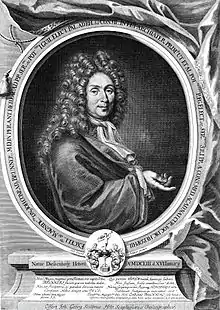Johann Conrad Brunner
Johann Conrad Brunner (16 January 1653 – 2 October 1727) was a Swiss anatomist, especially cited for his work on the pancreas and duodenum.[1]
Johann Conrad Brunner | |
|---|---|
 Portrait of Johann Conrad Brunner | |
| Born | 16 January 1653 |
| Died | 2 October 1727 (aged 74) |
| Education | Schaffhausen, Strasbourg and Paris |
| Medical career | |
| Profession | anatomist |
Life
Brunner was born in Diessenhofen,[2] and studied medicine in Schaffhausen, Strasbourg, Amsterdam, London and Paris. At Schaffhausen he studied under Johann Jakob Wepfer (1620–1695), who was also his father-in-law. He received his doctorate in 1672 from the University of Strasbourg.[2] Beginning in 1686 he was a professor of anatomy and physiology at the University of Heidelberg.[2] In 1716, Brunner was appointed personal physician to Charles III Philip the new Elector of the Palatinate.[2] He received many accolades during his life including a knighthood with the title "Brunn von Hammerstein".[2] He died in 1727 in Mannheim, Germany.[1]
Work
Brunner is remembered for his experiments and studies of the pancreas and the internal secretions associated with that organ. In 1683 he removed the pancreas from a dog and noticed that the animal experienced extreme thirst and polyuria. Despite his intuitive grasp of the connection between the pancreas and diabetes, he was unable to provide a theoretical link for the role of the pancreas in that disease. He published his findings on pancreatic research in a treatise titled Experimenta Nova circa Pancreas. Accedit diatribe de lympha & genuino pancreatis usu.
in 1687 he described tubuloalveolar glands in the submucous layer of the duodenum, which were later named Brunner's glands. Two disorders associated with these glands are:
- "Brunner's gland hyperplasia": Hypertrophy of Brunner's glands in the submucosal layer of the duodenum.
- "Brunner's gland adenoma": Polyp-like tumours arising from Brunner's glands.
Written works
- Poetum monstrosum et bicipitem, Diss. med. Strassburg 1672
- De glandulis in duodeno intestino detectis, Heidelberg 1687
- Experimenta nova circa pancreas; accedit diatriba de lympha et genuina pancreatis usu, Amsterdam 1682, nov ed.: Leyden 1722
Notes
- Smith, Benjamin Eli, ed. (1918). "Brunner, Johann Conrad". The Century Cyclopedia of Names. (The Century Dictionary Volume IX). New York: The Century Company. p. 189.
- Hirsch, Aug. (1876). "Brunner, Joh. Konrad B.". Allgemeine Deutsche Biographie. 3. p. 447.
References
- Description of Experimenta Nova circa Pancreas
- Diabetes, Doctors and Dogs
- List of publications copied from the German Wikipedia.